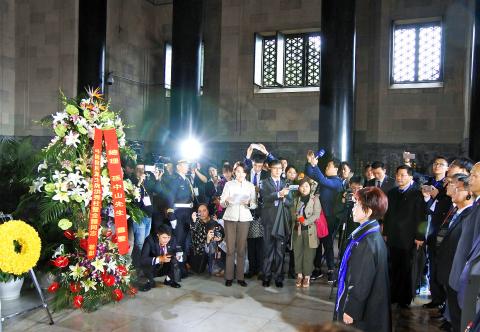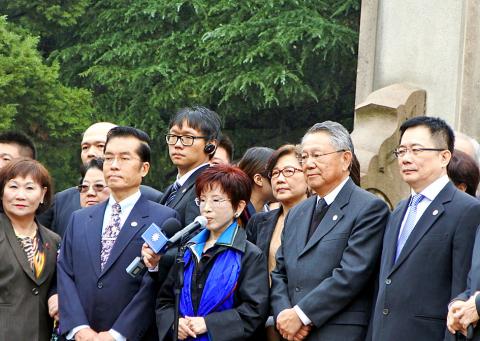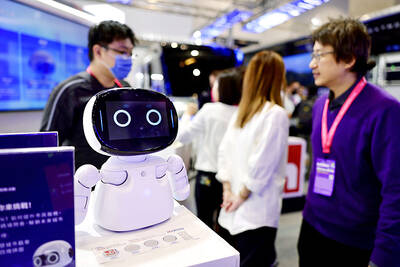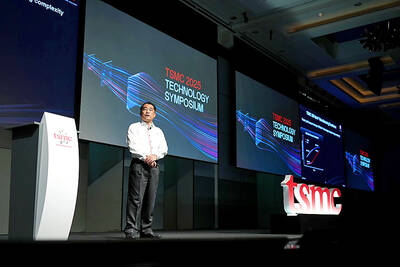Chinese Nationalist Party (KMT) Chairwoman Hung Hsiu-chu (洪秀柱) visited the mausoleum of Republic of China (ROC) founder Sun Yat-sen (孫逸仙) in Nanjing yesterday.
After an oration was read, Hung presented a wreath at the mausoleum. She and her delegation then bowed before a statue of Sun and observed a moment of silence.
Hung later told reporters that Sun established the ROC after toppling the Qing Dynasty and would always be the KMT’s leader.

Photo: CNA
Throughout his life, Sun was deeply patriotic, committed to revitalizing the Chinese nation and establishing a democratic republic of the people, for the people and by the people, she said.
Sun’s magnificent spirit is still extolled in Taiwan and China, Hung said, adding that the two sides can work to achieve national revitalization and economic prosperity by following his example.
Dozens of demonstrators gathered outside the mausoleum ahead of Hung’s arrival, demanding that the KMT’s contribution to the War of Resistance Against Japan be accorded more importance in China.

Photo: CNA
One demonstrator waved an ROC flag and shouted: “Long live the Republic of China” and “the Three Principles of the People unify China.”
Security guards at the site prevented onlookers from filming the demonstrators.
Hung later boarded a flight to Beijing, where she was scheduled to have dinner with China’s Taiwan Affairs Office (TAO) Minister Zhang Zhijun (張志軍).
Hung is today to meet with Chinese President Xi Jinping (習近平), who is also general secretary of the Chinese Communist Party (CCP), before attending tomorrow’s Cross-strait Peace Development Forum, an annual meeting held between the KMT and the CCP since 2006.
The Chinese-language Liberty Times (sister paper of the Taipei Times), Taiwanese online media outlet Up Media and the Mirror Weekly, earlier yesterday were informed by the TAO that Beijing has revoked the press passes of reporters from the three media outlets to the Hung-Xi meeting today.
No explanation was given.
Meanwhile, KMT Mainland Affairs Department Director Huang Ching-hsien (黃清賢) told reporters that the Hung-Xi meeting would “follow precedent,” meaning a closed-door event with media access limited to recording opening statements by the leaders and photographing a handshake.
The KMT and CCP are to give statements to the press separately after the meeting, sources said.
Presidential Office spokesman Alex Huang (黃重諺) said the government sees all unofficial exchanges with China in a positive light.
Taiwan and China should enhance mutual understanding and promote the peaceful development of bilateral relations through meaningful dialogue and exchanges without political preconditions, Huang said.
He also reiterated that all political parties in Taiwan should stand by the public and support government policy on cross-strait ties.

DEMOGRAPHICS: Robotics is the most promising answer to looming labor woes, the long-term care system and national contingency response, an official said Taiwan is to launch a five-year plan to boost the robotics industry in a bid to address labor shortages stemming from a declining and aging population, the Executive Yuan said yesterday. The government approved the initiative, dubbed the Smart Robotics Industry Promotion Plan, via executive order, senior officials told a post-Cabinet meeting news conference in Taipei. Taiwan’s population decline would strain the economy and the nation’s ability to care for vulnerable and elderly people, said Peter Hong (洪樂文), who heads the National Science and Technology Council’s (NSTC) Department of Engineering and Technologies. Projections show that the proportion of Taiwanese 65 or older would

Nvidia Corp yesterday unveiled its new high-speed interconnect technology, NVLink Fusion, with Taiwanese application-specific IC (ASIC) designers Alchip Technologies Ltd (世芯) and MediaTek Inc (聯發科) among the first to adopt the technology to help build semi-custom artificial intelligence (AI) infrastructure for hyperscalers. Nvidia has opened its technology to outside users, as hyperscalers and cloud service providers are building their own cost-effective AI chips, or accelerators, used in AI servers by leveraging ASIC firms’ designing capabilities to reduce their dependence on Nvidia. Previously, NVLink technology was only available for Nvidia’s own AI platform. “NVLink Fusion opens Nvidia’s AI platform and rich ecosystem for

Taiwan Semiconductor Manufacturing Co (TSMC, 台積電) yesterday said it is building nine new advanced wafer manufacturing and packaging factories this year, accelerating its expansion amid strong demand for high-performance computing (HPC) and artificial intelligence (AI) applications. The chipmaker built on average five factories per year from 2021 to last year and three from 2017 to 2020, TSMC vice president of advanced technology and mask engineering T.S. Chang (張宗生) said at the company’s annual technology symposium in Hsinchu City. “We are quickening our pace even faster in 2025. We plan to build nine new factories, including eight wafer fabrication plants and one advanced

‘WORLD’S LOSS’: Taiwan’s exclusion robs the world of the benefits it could get from one of the foremost practitioners of disease prevention and public health, Minister Chiu said Taiwan should be allowed to join the World Health Assembly (WHA) as an irreplaceable contributor to global health and disease prevention efforts, Minister of Foreign Affairs Lin Chia-lung (林佳龍) said yesterday. He made the comment at a news conference in Taipei, hours before a Taiwanese delegation was to depart for Geneva, Switzerland, seeking to meet with foreign representatives for a bilateral meeting on the sidelines of the WHA, the WHO’s annual decisionmaking meeting, which would be held from Monday next week to May 27. As of yesterday, Taiwan had yet to receive an invitation. Taiwan has much to offer to the international community’s